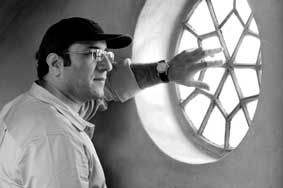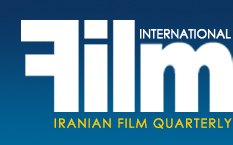|
Ebrahim Haghighi’s Interview with Reza Mirkarimi on "A Cube of Sugar"
Arranging the Dawn
|
 Few people remember his first film, The Child and the Soldier (2001) anymore. But everybody is taking Reza Mirkarimi seriously after his second film, Under the Moonlight (2002); a film with a sensitive subject for its time where the filmmaker was able to peel away without falling into false excitement and enthusiasm, and, by combining two different realms - one realist and the other melancholic – had a deep insight into the painful solitude of two people who fall apart from each other. A Light Is Burning Here (2003) was an entirely different approach with the filmmaker stuck in the superstructure of the story and the theme, and could not repeat the success of his prior work. However Mirkarimi came back with a spectacular film: So Far, So Close (2005) which had a modern atmosphere and, far from the familiar components of his previous films, had a different approach to his subject matter. It received positive reviews, with the jury of the Fajr Film Festival and the audiences applauding wholeheartedly for his efforts. Few people remember his first film, The Child and the Soldier (2001) anymore. But everybody is taking Reza Mirkarimi seriously after his second film, Under the Moonlight (2002); a film with a sensitive subject for its time where the filmmaker was able to peel away without falling into false excitement and enthusiasm, and, by combining two different realms - one realist and the other melancholic – had a deep insight into the painful solitude of two people who fall apart from each other. A Light Is Burning Here (2003) was an entirely different approach with the filmmaker stuck in the superstructure of the story and the theme, and could not repeat the success of his prior work. However Mirkarimi came back with a spectacular film: So Far, So Close (2005) which had a modern atmosphere and, far from the familiar components of his previous films, had a different approach to his subject matter. It received positive reviews, with the jury of the Fajr Film Festival and the audiences applauding wholeheartedly for his efforts.
Then, Mirkarimi took a big risk with As Simple as This (2008); an impossibly simple story about the day-to-day life of a woman from a religious middle-class background. The script had a clever structure, putting together a series of diverse dramatic situations in a masterly manner, seeming improvised day-to-day events, and this would have a decisive role in the making of another valuable work from Mirkarimi.
Now, with A Cube of Sugar, Mirkarimi has achieved an impressive and envious quality in representing the details of his characters’ lives, showing specific accounts of their relationships. In this film, we have a minimalistic and meticulously prepared script, and the Mirkarimi’s execution is very seasoned and solemn which has been ratified by many as a new standard in filmmaking in the Iranian cinema. In A Cube of Sugar, Mirkarimi, a graduate of graphic design, has used his main expertise in a more evident and spectacular manner and has created a work full of light and color and a certain passion for life. That’s why we have asked a renowned graphic designer and a master of the art on his own, Ebrahim Haghighi, to conduct the interview with the director and give us an analysis of the film.
*
Ebrahim Haghighi: Every time I’ve watched the film, I’ve decided to pay more attention to certain details and every time I get so involved in the story that I forget about those details. Sometimes a work of art, such as a movie or a piece of music, has so much artistic capacities that you can watch it (or listen to it) many times, and enjoy it every time. I think this film was a work of art with multiple capacities and, therefore, I consider it one of the outstanding films of the Iranian cinema that will be understood more and more in the future. You are a graphic artist and that makes you more sensitive to form. I think this is so obvious in your other films as well. But before we discuss the form, let’s talk about the script. This film proves one more time that a tight script has an undeniable effect on the film’s quality. How did you get the original idea about the story and how did it evolve into this script?
Reza Mirkarimi: It seems a simple and repetitive question, but it’s actually a tough one. I can’t really remember where did I get the first ideas about my last three films and I can’t even recall whether the form and the shape preceded the story and the content or vice versa. Maybe it’s because there is no storyline or a cohesive structure to begin with, but it’s just a few individual images, and I have first been influenced by an atmosphere which obsesses me to go on and discover it. For instance, one of the episodes in Persian Carpet (an episodic film made by 15 Iranian directors, 2007) was made in the city of Ardekan. We needed a family for that episode and we found one right there in that city, who agreed to play in our film. All of the family members participated and performed so well and warmly in their roles. Our camera was wandering about in Yazd and Ardekan (two central cities of Iran) because the cameraman was a kid who didn’t have enough experience in camera work. This wandering camera and this suspended space that could be felt in the realms of architecture and carpets and clothes and also among relationships of the people, made me think about making a film which would hover over an Iranian family, have everything and everybody have a similar part in giving some kind of a depth to this space. Then, we decided that we wanted fewer events in the story and not to follow a cause-and-effect type of storyline. We eventually arrived at a bunch of details that are captivating enough so we wouldn’t need any events and adventures. Just like a carpet that is lying under our feet. When we first see a carpet, we don’t notice all of its details, but it gives us a certain peace and tranquility and invites us to sit or lie down on it. These details are not there to show off, but are there to help to give a shape to the whole. At the same time, however, if you look at a close shot of the carpet, you see that all details are very nicely put together. Based on this approach, I referred to my childhood memories, and then we started to tell a story that would put all these memories together and eventually we arrived at A Cube of Sugar. That year, we made As Simple as This, after which I felt I had more important things to say and I decided that I couldn’t use that form to tell those things. After a while, however, I realized what seems to be more important to me is this film. Then I started to revise the whole thing, and I tried to combine what preoccupies me today: how do words such as sadness, nostalgia, anxiety, love, happiness and the Iranian family fit into this culture?
... To Be Continued
[Page: 76]
|
|
|
|
|
President & Publisher
Massoud Mehrabi
Editors:
Sohrab Soori
Massoud Mehrabi
Translators:
Sohrab Soori
Vazrik Der-Sahakian
Behrouz Tourani
Zohreh Khatibi
Contributors
Mehrzad Danesh
Advertisements
Mohammad Mohammadian
Art Director
Babak Kassiri
Ad Designers
Amir Kheirandish
Hossein Kheirandish
Cover Design
Alireza Amakchi
Correspondents
E.Emrani & M. Behraznia (Germany)
Mohammad Haghighat (France)
A. Movahed & M. Amini (Italy)
Robert Richter (Switzerland)
F. Shafaghi (Canada)
B. Pakzad (UAE)
H. Rasti (Japan)
Print Supervisors
Shad-Rang
Noghreh-Abi
Gol-Naghsh
Subscription & Advertising Sales
Address: 10, Sam St., Hafez Ave., TEHRAN, IRAN
Phone: +98 21 66722444
Fax: +98 21 66718871
info@film-magazine.com
Copyright: Film International
© All rights reserved,
2023, Film International
Quarterly Magazine (ISSN 1021-6510)
Editorial Office: 5th Floor, No. 10
Sam St., Hafez Ave., Tehran 11389, Iran
Printed in Tehran
Publishing Date Summer 2011
*
All articles represent views of their
authors and not necessarily
those of the editors
|
|
|

